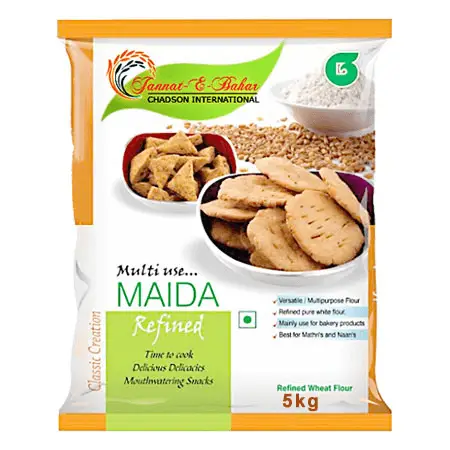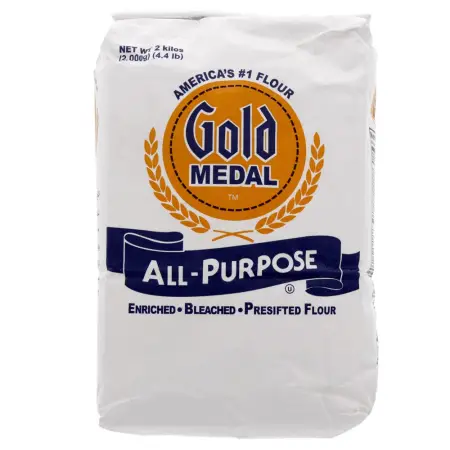Even if you are not a professional baker, you probably know what all-purpose flour is. But do you know that there is another type of flour called maida flour? If you have never heard of it, this article is for you. This article will focus on the difference between maida flour and all-purpose flour.
- 1 Summary Table
- 2 Descriptions
- 3 Maida vs All-Purpose Flour
- 4 What are the different dishes that maida and all-purpose flour can be used for?
- 5 What is the difference between maida and atta?
- 6 Maida vs atta? Which one is better for you?
- 7 Is all-purpose flour gluten-free?
- 8 Is all-purpose flour maida or atta?
- 9 How to make self-raising flour out of all-purpose flour?
Summary Table
| Maida Flour | All-Purpose Flour |
| Soft and very fine; has a texture similar to cake flour | Soft but not as fine as maida flour |
| Typically bleached | Can be bleached or unbleached |
| Primarily used in making traditional Indian flatbreads but can also be used in cooking and baking recipes | All-around and can be used in any cooking and baking recipe |
| Can store for up to 8 months | Can store for up to a year |
| Extensively used in Asia | Most common type of flour in the United States and Canada; readily available in grocery stores and supermarkets |
Descriptions

Maida flour originally came from India. It is milled from the “endosperm” which is the starchy part of the grain. During the process, the fibrous bran is removed from the soft or hard wheat and then the white starch left is refined by sieving into white flour. The result is soft, fine flour which looks like cake flour from the United States. Maida is naturally yellowish in color, but it is typically bleached either by a natural or chemical process.
In hindi name, maida is defined as “all-purpose flour” by food enthusiasts because of its versatility in the kitchen. It is used to make traditional flatbreads (tandoori roti and naan), bhatoora, parathas, chapatis, puris kulcha, cake, biscuits, tortilla, pizza crust, and other pastries. Aside from being used for baking bread, it is also used to thicken sauces, coat fried foods, and as an ingredient in several traditional recipes. Maida is also widely used in Central Asia and Southeast Asia.
Maida flour has a low protein content due to the bleaching process and its exposure to heat during milling. It mainly contains carbohydrates which is why it is considered an unhealthy flour according to health experts.
Maida can store for up to 8 months as long as it is kept in a cool, dark, dry place in a breathable container.

On the other hand, all-purpose flour is a type of flour that is made from a combination of soft and hard wheat. It does not contain added leavening agent which is why it is also called “plain flour” in some areas. It can be bleached or unbleached. It has a protein content of 10-13%.
All-purpose flour is perfect for sauces, soups, pancakes, bread, cake, muffin, cupcakes, cookies, pizza crust, biscuits, and other baked goods. It is the most common type of flour and it is readily available in grocery stores and supermarkets. It can store for up to a year.
Maida vs All-Purpose Flour
What, then, is the difference between maida and all-purpose flour?
Maida flour was originally used in India to make traditional flatbreads whereas all-purpose flour was not. In India, however, name: maida flour is also called “all-purpose flour” because it is very versatile in the kitchen, just like the all-purpose flour sold across the United States and Canada.
When it comes to texture, maida flour is noticeably softer and finer than all-purpose flour. Also, maida flour is typically bleached, whereas all-purpose flour can be bleached or unbleached, similar to bread flour. All-purpose flour is readily available in supermarkets and grocery stores in the United States and Canada, but it can be difficult to find maida flour at times. Maida flour is extensively used in Central Asia, South Asia, and Southeast Asia.
Moreover, maida flour can store for up to 8 months, while all-purpose flour can last up to a year if kept in a cool, dry, dark place. So, if you are looking for a long-lasting product, maida is the one to go for. When it comes to taste, both are of equal quality. All-purpose flour produces a slightly lighter texture and flavor than maida flour. Both are ideal for baking bread, but it is recommended to use all-purpose flour when making breads, cakes, pastries, and desserts that will be eaten immediately.
What are the different dishes that maida and all-purpose flour can be used for?
Maida flour is best known as a basic ingredient for preparing flatbreads and breads. It is also used in many other Indian dishes such as: chapathis, samosas, puris, bhaturas, and kachoris. You can make a variety of Indian flatbreads using maida flour such as: roti (Indian flatbread), parathas (Indian flatbread), naans (Indian flatbread), and phulkas (Indian flatbread). Maida flour is also used in many Indian desserts such as: malpuas, gulab jamun, kheer (rice pudding), halwa (sweet dessert), and barfi (Indian sweet).
All-purpose flour can be used to prepare a variety of dishes such as: pies, cookies, crackers, pancakes, waffles, breads, muffins and cakes. All purpose flour is also used to make gluten-free baked goods. In short, you can use both maida and all-purpose flour for making a variety of Indian dishes.
What is the difference between maida and atta?
Now that you know the difference between maida and all-purpose flour, let’s look at the differences between maida of atta flour and all-purpose flour.
Maida is a finely ground whole wheat flour with larger particles of less than 1 mm. The whole wheat grain is separated into the bran, germ and endosperm, while the large bran particles are removed to provide the finest Indian-style flour available. The small endosperm particles (about 0.5 mm) give the flour its high protein content and lightness in texture. Maida is used to make roti, chapatis, parathas and other Indian breads, and for making traditional Indian sweets such as kheer (rice pudding) and halwa.
This is the most commonly used flour in India and is available in different grades. Atta is a less refined whole wheat flour with larger particles of between 1 – 2 mm. It is ground finer than maida and used for making all purpose flour and other wheat based products like rotis.
Atta is a finely ground flour from rice, wheat or corn. It is used to make roti, chapati, paratha and other plain Indian breads and to make basic Indian sweets such as halwa (rice pudding).
Atta is also used to make other types of flatbreads, including naan and roti. Atta is also used to make breads with a sourdough-like texture.
Maida vs atta? Which one is better for you?
Maida all purpose flour has the highest protein content of any Indian pastry flour, making it perfect for making chapatis, rotis and various other Indian breads. It is also nutritious as it contains all the necessary amino acids required by humans, thus maintaining good health.
Atta all purpose flour has a slightly lower protein content than maida. It is also suitable for making many staple wheat-based products like roti, chapati and paratha. However, its finer particles make it more prone to burn during the process of cooking or baking.
Is all-purpose flour gluten-free?
No, all-purpose flour is not gluten-free. It’s actually moderately high in amylase activity because of the high gluten content, so if you have a wheat allergy or sensitivity, this will be an issue. But for the rest of us, it’s usually fine.
Whether the all-purpose flour consists of maida or atta, it does contain gluten content in the form of gluten, and some people have reactions to it.
All purpose white flour is usually made from wheat flour, but some manufacturers add a small amount of corn starch to make it lighter. The corn starch also makes the dough easier to knead.
Is all-purpose flour maida or atta?
Yes, both maida and atta are all-purpose flours. It depends on the purpose for which you want to bake or cook. As mentioned, Maida is used for making rotis, while atta is used for making chapatis, parathas and other Indian breads.
When it comes to baking, maida is generally preferred as it gives a softer texture to the bread. This is because all purpose flour has a high protein content and absorbs more moisture from the ingredients being used for making bread. On the other hand, atta has a finer particle size, making it more prone to burning during the process of cooking or baking.
All-purpose flour is a term used for a single type of flour that can be used for many different purposes, including making breads, cakes, pizza, cookies and many other products. This is why most people get confused about this term, as they think it is similar to the term “whole wheat flour”.
How to make self-raising flour out of all-purpose flour?
Self-raising flour is a type of leavening agent that contains baking powder and salt. It’s used to make bread rise, and it can be substituted for baking powder in most recipes.
This is a good way to make self-raising flour. This recipe uses all-purpose flour and works well for cakes, cookies, white bread, and scones. The important thing is to make sure that the all-purpose flour has been sifted before measuring it out.
What you need:
• 1 cup of all-purpose flour (plain, not self-raising)
• 1/2 teaspoon of baking powder (this is optional)
How to do it:
Mix the all-purpose flour and baking powder together. The best way to do this is to use a large bowl, but if you don’t have one, then use a spoon or fork. Pour the flour mixture into the self-raising flour and mix well.
You can then use it immediately or store it in an airtight container for up to two weeks.
If you have high blood sugar, you can also substitute the all-purpose flour with coconut flour while making self-rising flour. Compared with regular all-purpose flour, Coconut flour contains lower carbs.





